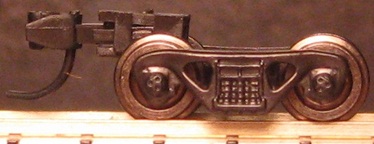



Manufactured in the 1930s and 1940s, the National B-1 friction bearing truck was designed to improve service and reduce maintenance costs by eliminating unnecessary parts. It was the first plankless truck, and had a unique spring package featuring stabilizing wedges. Available in "all-sprung" and "dual control" versions, the B-1 design provided greater strength, more flexibility and less weight. The premium dual control version employed hardened steel trunions and sleeves to give the truck a better ride. These also helped to keep the truck square. Early versions of the B-1 resembled ARA "Type Y" trucks across the top cord. After the mid-30s, the top cord was changed to more resemble AAR double-truss trucks.
In common use until the mid-60's, the B-1 eventually fell out of favor due to the fact that the bolster and spring parts for the two versions could not be mixed (although some shops tried). In fact, some carriers actually embargoed interchange cars with B-1 trucks unless the owner road was willing to supply replacement parts and/or trucks to fix them. Towards the end of the 1960s, the AAR finally banned cars using B-1 trucks from interchange.
The PRR had a unique all-sprung version (class 2D-F13) that had a leaf/elliptical spring in the bottom (as opposed to coil springs). Circa 1947, the AC&Y purchased a number of 70-ton covered hoppers that were equipped with B-1 roller bearing trucks (possibly the only B-1's ever made with standard bolt-in roller bearing units).
Micro-Trains makes the only National B-1 in N scale. For modeling purposes, the all-sprung and dual control versions of the friction bearing B-1 are virtually indistinguishable from one another. Consequently, the Micro-Trains truck can stand in for either -

The C-1 replaced National's earlier B-1 truck around 1946. Like the more popular ASF A-3 and Barber S-2 trucks, the C-1 was a "ride control" truck (just with its wedges located on top). 50 and 70-ton friction bearing versions of the C-1 were built through the 1950s and remained in service until the 1990s (when all solid-bearing trucks were banned from interchange). The Atlas C-1 truck is a 70-ton version (modeled after the trucks used on GN's Hart Ballast hoppers) -

50, 70, and 100-ton roller bearing versions of the C-1 were built in the 1960s and 1970s (and likely remain in service to this day). Unfortunately, there are no N scale models of these trucks per se, although I'm told that Con-Cor's 70-ton roller bearing truck is at least close -

Micro-Trains B-1 - wheelbase 10.2mm, frame width 15.61mm, wheel size 33", axle length 13.7mm
Atlas C-1 - wheelbase 9.8mm, frame width 16.12mm, wheel size 33", axle length 13.25mm